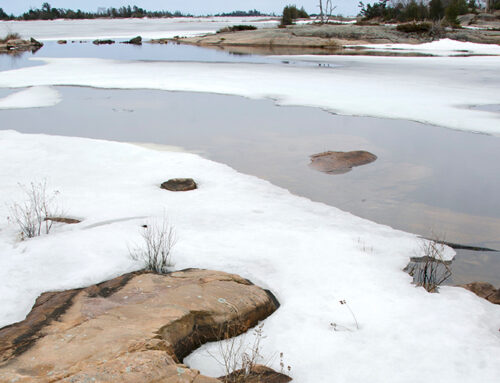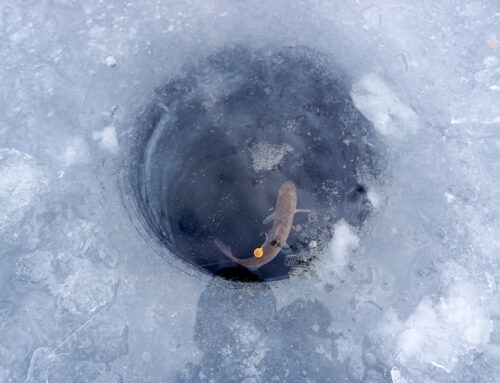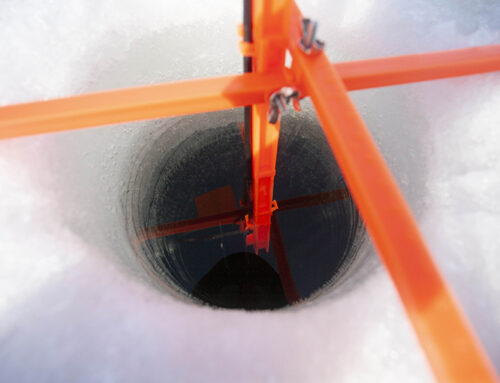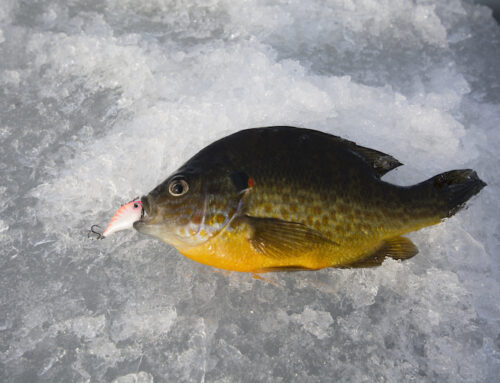
Somewhere in my DNA there’s a dominant “explorer” gene. Finding walleye on a lake I haven’t ice fished before is a thrill that never gets old. But, winter prospecting brings unique challenges and I’ll admit I’ve had my share of outings that didn’t go as planned. It’s all part of the game, and exploration is a good teacher.
The next time you ice fish a new lake, consider these practices and tips that I’ve learned through experience.
Scout in autumn
Ideally, you should scout a lake from a boat in autumn before ice fishing it. Having GPS waypoints for bars, humps, productive flats, and healthy weeds near deep water will pay off when you return in winter. If you’re unable to explore a lake in the fall, all is not lost. You can still source information to boost your chances of success.
Promising real estate
Highlight potential structures on a map before heading out. Walleye don’t follow a rulebook, but certain areas are better than others throughout the winter. Moderate to deep structures are textbook spots. Walleye will have different depth preferences from one lake to the next. Eighteen to 30 feet depths command my attention when I study maps.
In addition to humps and reefs, I’m a big fan of shoreline points and bars that extend into deep water. These elongated structures act as corridors for fish movement. It’s common to catch walleye off the deep end during the day, then progressively shallower as dusk turns to night.
Dig for more intel
If you’ve never been on the lake, additional background is helpful. Cottage association or conservation authority reports are good sources to learn about the state of the lake, including water clarity, maximum depth, and fish species. This is useful information, as walleye will behave differently in a shallow, weedy lake versus a deep, infertile system filled with rocky structure. If the water’s stained, walleye may be more active during the day. If it’s clear, overcast days and dusk may be the best times.
A call to a local tackle shop may also provide this info, along with ice conditions, snow cover, access points, and, if you’re lucky, a fishing report. Inquire about minnow availability. Fresh minnows are must-haves on any exploration trip.
When mapping, review a contour map of the lake, or use Google Earth satellite imagery. It’s amazing how many shallow reefs, bars, and island points are visible. These features are sometimes the mere peaks of deeper structures and can provide clues for where to start.
I also visit the Ministry of Natural Resources and Forestry’s Fish ON-Line tool to see the species in the lake, and if there have been any recent stocking efforts. Check the provincial fishing regulations (in print or online) as a standard practice, too.
Determine road access
Research on road and trail conditions is as criti- cal as determining lake access points. Some of this can be done online, but taking a drive to see things first-hand is wise if heading into unfamiliar territory. Last year, I had a small lake earmarked for ice exploration but, sadly, access wasn’t avail- able. I was glad to scratch it off the list on a Sunday drive rather than being rejected by snow banks and private property signs with a group of bud- dies and gear in tow.
Power and finesse
I carry lots of baits when exploring lakes. Jigging minnows, spoons, and darters top my list. They’re great for searching tactics and triggering bites. I tip baits with minnow meat or scent-loaded soft-baits. Soft-plastic minnow and jig combos in different sizes are also worth packing. Once I’ve located walleye, I often set a dead-stick rod to catch more fish.
Winter weather can change the landscape overnight, so have a back-up lake to fish should things not go as planned with your primary destination. Plan Bs have salvaged many ice outings for me over the years.
More minds and more lines
Exploring in a group is a good idea. Teaming up with friends to track down walleye makes for fun times and shortens the learning curve. There’s also the advantage of safety in numbers.
Four is a good group size, as you can branch off in twos as you try different baits, depths, and jigging tempos. Stay in contact through huddle-ups, texts, or 2-way radios on what is and isn’t working.
Electronic advantages
Having cutting-edge electronics helps locate and catch fish. A handheld or GPS/sonar combo is essential for returning to spots identified on scouting sessions. Be sure to save your starting point too, so you can find your way back safely. This practice is a god-send in fog or heavy snow.
Underwater cameras are useful in clear water lakes. I’m completely sold on the latest generation of pocket-sized underwater cameras, like the Aqua-Vu Micro, for ice fishing. These compact units do just as good a job of displaying what’s below as the larger units, yet are small enough to fit in an ice-suit pocket. A camera can show forage, structural elements below, and walleye, if they are in the area.
Give a lake a chance
Many days, winter brings tough fishing. It’s possible your outing was simply bad timing. Give the lake a chance to provide you with insights into winter walleye behaviour and show you its true colours.
Locating and patterning walleye in winter is a challenge, but, victory sure tastes sweet when the day ends with a dinner of fresh fillets.

As with any ice adventure, safety should be your number one lake-exploring priority. Don’t trust snow trails or other anglers as a sign of safe ice. Test conditions yourself and test ice regularly.
Tim Allard is a full-time freelance journalist and photographer based in Ottawa. He’s the author of the multi-award winning book Ice-Fishing – The Ultimate Guide. Reach Tim at mail@niteowldev.com
Originally published in the Jan.-Feb. 2015 edition of Ontario OUT of DOORS magazine.






Leave A Comment